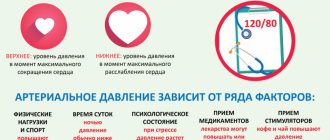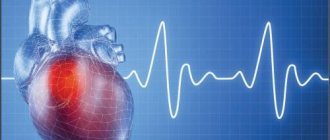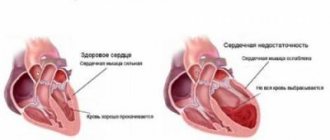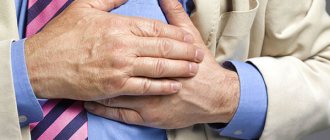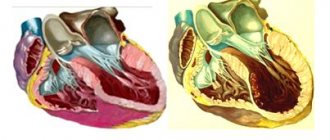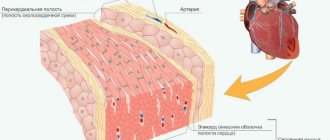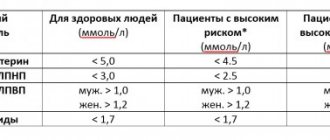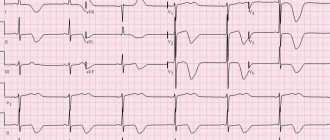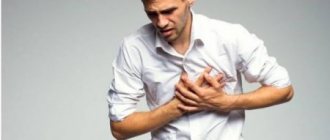Cardiac diseases
- Heart failure
- Myocardial infarction (heart attack)
- Angina pectoris
- Hypertension (high blood pressure)
- Atherosclerosis
- Heart defects (congenital and acquired): aortic stenosis, aortic insufficiency, mintral valve stenosis, mitral valve insufficiency, atrial septal defect, ventricular septal defect, etc.
- Heart diseases characterized by the development of inflammatory processes in the pericardial sac (pericardium): pericarditis, pericardial effusion
- Myocarditis (inflammatory disease of the heart muscle)
- Endocarditis
- Arrhythmias: atrial fibrillation, bradycardia, tachycardia, etc.
- Pulmonary hypertension (increased pulmonary artery pressure)
- Heart tumors
- Cardiomyopathy
- Asystole (this is a condition in which the heart stops)
Breeds of cats and dogs at risk for heart disease
Cardiological examination should be carried out not only for obvious problems, but also for the purpose of prevention in animals with a breed predisposition to diseases of the cardiovascular system. More than 30 breeds of dogs and cats are at risk. Below is a list of the most popular breeds and the diseases associated with them.
- Beagle - pulmonary valve stenosis.
- Boxer - pulmonary valve stenosis, dilated cardiomyopathy, persistent atrial asystole.
- Chihuahua - pulmonary valve stenosis, atrioventricular valve endocardiosis.
- Cocker spaniel - patent Botallov duct, pulmonary valve stenosis, atrioventricular valve endocardiosis, dilated cardiomyopathy.
- Doberman - dilated cardiomyopathy.
- English Bulldog - pulmonary valve stenosis.
- Fox Terrier - pulmonary valve stenosis, atrioventricular valve endocardiosis.
- German Shepherd – patent ductus Botall, subaortic stenosis, dilated cardiomyopathy.
- Miniature poodle - patent Botallov duct, endocardiosis of the atrioventricular valve.
- Pekingese - endocardiosis of the atrioventricular valve.
- Spitz - non-closure of the ductus Botallova.
- Labradorite - atrioventricular valve dysplasia, exudates in the pericardium.
- Golden retriever - atrioventricular valve dysplasia, pericardial exudates.
- Saint Bernard - dilated cardiomyopathy.
- Yorkshire Terrier - endocardiosis of the atrioventricular valve.
- Devon Rex - hypertrophic cardiomyopathy.
- British cat - hypertrophic cardiomyopathy.
- Maine Coon - hypertrophic cardiomyopathy.
- Scottish fold is a hypertrophic cardiomyopathy.
The most dangerous heart defects
Heart failure
Heart failure is a condition that occurs when the heart is unable to pump large amounts of blood or the filling of the heart is reduced. In this condition, the heart is forced to work harder to pump blood throughout the body. Heart failure can cause minor symptoms or can be life-threatening.
Atherosclerosis
In healthy people, blood flows freely through the arteries to all parts of the body, supplying them with oxygen and other nutrients. With atherosclerosis, plaques (hardenings) form on the inner wall of the arteries, which leads to narrowing of the arteries, and in some cases, complete blockage.
What is atherosclerosis? Causes, symptoms and treatment
Heart attack (myocardial infarction)
A heart attack occurs when blood flow to the heart muscle is blocked, the tissue is starved of oxygen, and part of the myocardium (heart) dies. This serious disease can be fatal. Treatment is with medications or surgeries such as stent placement or angioplasty.
Atrial fibrillation
This is a disease in which the heart beats irregularly.
Hypertension
High blood pressure is the most common cardiovascular disease. This can affect many other organs, such as the kidneys, eyes, and nervous system.
Chemotherapy: how to treat cancer, side effects
Meaning of the word cardiology
cardiology
(from cardio... and...logy), a branch of medicine that studies the structure, function, diseases of the heart and blood vessels, the causes of their occurrence, mechanisms of development, clinical manifestations, diagnosis, as well as developing methods of treatment (including surgical), prevention, issues of medical rehabilitation of patients with lesions of the cardiovascular system. Medicine originated in the depths of therapy, surgery, pediatrics, neuropathology, physiology, normal and pathological anatomy, and pharmacology in connection with the increasing number of cardiovascular diseases; under the influence of the development and improvement of methods for studying the circulatory system, the accumulation of knowledge about the causes and mechanisms of development of heart and vascular diseases, the development of methods for their treatment and prevention, it emerged in the 19-20 centuries. into an independent medical discipline. While maintaining his connections with many medical sciences, K. uses research methods characteristic of them. Fragmentary information about the structure of the human cardiovascular system can be found in ancient sources. The first blood circulation scheme was developed by the Roman physician C. Galen (2nd century). This scheme lasted until the 17th century. and was refuted by the work of the English scientist W. Harvey, “Anatomical Discourse on the Movement of the Heart and Blood in Animals” (1628). With Harvey's discovery of the laws of blood circulation, a rapid accumulation of both anatomical, physiological and clinical data on the cardiovascular system began. In the 17th-19th centuries. Coronary circulation, individual heart defects, and angina pectoris were described. The diagnosis of many heart diseases was facilitated with the introduction by the French physician R. Laennec of the method of listening (auscultation) using a stethoscope (1819). A great contribution to the anatomical and physiological knowledge of the cardiovascular system was made in the 19th century. Czech physiologist J. Purkinė (1839), who studied the cellular structure of the heart muscle, German physician W. Gies (1890-1894), German pathologist L. Aschoff, Japanese pathologist S. Tawara (1906) and English A. Keys and M. Flack ( 1907), who identified and described the elements of the cardiac nervous system. The German physiologist K. Ludwig discovered the common vasomotor center in the medulla oblongata; proposed methods for recording blood pressure and determining blood flow speed. In Russia, a significant contribution to K. was made by S. P. Botkin, who determined the best place to listen to diastolic murmur in aortic insufficiency (III-IV left intercostal spaces) - 'Botkin's points'. The heyday of physiology at the end of the 19th century. and the beginning of the 20th century, in particular the works of Russian scientists I. M. Sechenov, I. F. Tsion, A. B. Fokht, physiologists I. P. Pavlov, V. Ya. Danilevsky, L. A. Orbsley, K. M. Bykov, V. N. Chernigovsky, the French physiologist C. Bernard, the English scientist E. G. Starling and others contributed to the development of the functional direction in medicine. New research methods were introduced: in 1903 the Dutch scientist W. Einthoven recorded biocurrents human heart - electrocardiography (later this method was improved and developed as a result of the work of Russian physiologist A.F. Samoilov and Soviet clinicians V.F. Zelenin and L.I. Fogelson, English doctor T. Lewis, German K.F. Wenckebach ); the sound method for determining blood pressure was proposed in 1905 by the Russian doctor N. S. Korotkov. Of great importance for the diagnosis of diseases of the cardiovascular system was the introduction into the clinic of fluoroscopy and radiography of the heart, contrast angiocardiography, X-ray and electrokymography, phasorradiography, catheterization of the heart and blood vessels, radiocardiography, phono- and ballistocardiography, and the method of diluting dyes for studying the hemodynamics of ultrasound cardiography. , immunology, etc. The Soviet physiologist E. B. Babsky proposed an original method for studying cardiac activity - dynamo-cardiography. The founder of clinical cardiology is considered to be the English physician J. Mackenzie, who in 1902 published the first scientific work devoted to a comprehensive study of arrhythmias, in 1908 a work on heart disease, their diagnosis and treatment, and in 1923 on angina pectoris. A major role in the study of circulatory pathology was played by the work of the French doctor A. Hushar, known for his manual on blood circulation (1893), the English doctors T. Lewis and J. W. Pickering and the German E. Romberg, the American W. Osler and many others. One of the largest modern cardiologists is the American doctor P. D. White, who carried out major clinical and epidemiological studies of atherosclerosis and coronary insufficiency, septic endocarditis, syphilis of the cardiovascular system and rhythm disturbances. American scientists K. Ungers and L. Katz studied the dynamics of blood circulation. V.P. Obraztsov and N.D. Strazhesko described in detail the clinical picture of thrombosis of the coronary arteries of the heart and myocardial infarction (1909). G. F. Lang put forward and developed the neurogenic concept of hypertension, which was further developed in the works of A. L. Myasnikov and his colleagues. G. F. Lang developed a classification of diseases of the cardiovascular system, approved by the 12th All-Union Congress of Therapists (1935), according to which each disease should be characterized from various aspects - etiological, pathoanatomical, pathological-physiological, functional and symptomatological. At the same congress, the classification of circulatory failure proposed by Strazhesko and V. Kh. Vasilenko was adopted. Research by N. N. Anichkov and S. S. Khalatov on the creation of experimental cholesterol atherosclerosis allowed them to formulate the cholesterol theory of atherosclerosis, which became widespread and made it possible to reveal the main pathogenetic mechanisms of this disease. The work of Soviet cardiology has revealed the leading role of nervous regulation disorders with subsequent humoral disorders in the occurrence and course of hypertension, atherosclerosis and coronary insufficiency. These ideas were successfully developed by A. L. Myasnikov. The works of P. E. Lukomsky and B. V. Ilyinsky on the study of atherosclerosis and coronary insufficiency are widely known. The role of nervous factors in the mechanism of development of atherosclerosis was shown by I.V. Davydovsky, E.M. Tareev and others. Various aspects of the problem of angina pectoris and myocardial infarction were developed by G.F. Lang, M.S. Vovsi, M.M. Gubergrits, V. F. Zelenin, M. N. Tumanovsky, etc. D. D. Pletnev and V. Kh. Vasilenko studied complications of myocardial infarction (thrombembolism, etc.). A significant problem of K. are rheumatic heart defects, studied both by pathologists (V. T. Talalaev, M. A. Skvortsov, N. A. Kraevsky, A. I. Strukov) and clinicians (M. P. Konchalovsky, M. V. Chernorutsky, N. D. Strazhesko, A. I. Nesterov, E. M. Gelshtein, I. A. Kassirsky, etc.). The clinic of septic endocarditis was studied by G. F. Lang, N. D. Strazhesko, N. A. Kurshakov, N. S. Molchanov, E. M. Tareev, etc. Various dysfunctions of the heart muscle were also studied. G. Etinger, V. Kh. Vasilenko, A. A. Kedrov, many issues of the problem of “pulmonary heart” were developed in detail by the Soviets. scientists B. E. Votchal, V. F. Zelenin, V. Kh. Vasilenko, B. E. Kogan, B. I. Kushelevsky, P. E. Lukomsky, V. V. Parin, N. N. Savitsky. From the middle of the 20th century. Radioactive isotopes have been used in the study of the cardiovascular system. Some long-known methods (phlebography, oscillography) began to be used in the clinic using advanced electronic equipment. For the development of a system for organizing care and the introduction into practice of new methods of treating myocardial infarction (anticoagulants, fibrinolysin), state prizes were awarded to V. N. Vinogradov, P. E. Lukomsky, E. I. Chazov and Z. I. Yanushkevichyus. V.V. Zakusov and others developed the problems of pharmacotherapy of cardiovascular diseases. The high level of technological development and modern methods for diagnosing the state of the cardiovascular system have made surgical interventions for cardiovascular diseases available. The development of surgical treatment of heart defects was one of the incentives for the broad development of diagnostic and clinical issues of these diseases. Surgeries for coronary insufficiency, removal of blood clots, etc. were performed. In 1967, Cape Town surgeon K. Barnard performed the first human-to-human heart transplant in the history of medicine. By 1972, over 200 such operations had already been performed in the world (in the USA, France, USSR, etc.). In the USSR, surgery of the heart and blood vessels is successfully developing thanks to the work of Soviet surgeons A. N. Bakulev, B. V. Petrovsky, P. A. Kupriyanov, A. A. Vishnevsky, V. I. Kolesov, N. M. Amosov, E. N. Meshalkin, awarded Lenin Prizes. The state prize was awarded to A. A. Vishnevsky, N. L. Gurvich, V. A. Negovsky, B. M. Tsukerman and others for the development and implementation of electric pulse therapy. Abroad, significant achievements in heart surgery were achieved by K. S. Beck, C. R. Bailey, A. Blalock, L. O'Shaughnessy, P. D. White, A. Dogliotti, W. B. Cannon, M. de Becky , D. Cooley, K. Lillehai, etc. An independent branch of blood medicine is experimental medicine, which is a complex of physiological, pathophysiological, biochemical and morphological studies conducted to study the circulatory system in normal and pathological conditions. The main directions of modern experimental medicine are issues of clinical physiology of blood circulation; regulation of vascular tone in normal and pathological conditions; physiology and pathology of coronary circulation (in particular, myocardial infarction), contractile function, automatism and excitability of the heart in normal and pathological conditions; compensatory hyperfunction, hypertrophy and failure of the hypertrophied heart; physiology and pathology of pulmonary circulation; physiology and pathology of regional and capillary circulation; pathogenesis of atherosclerosis. These problems are being successfully developed both in the USSR and abroad. In 1963, the All-Union Cardiological Society was organized, which is part of the International and European Associations of Cardiology, as well as republican societies. The International Heart Association was founded in1950. It includes the European, Asian, Pacific, Inter-American Associations of Cardiology. In the USSR, cardiac care is provided in cardiology departments, in clinics - cardio-rheumatology offices, performing therapeutic and advisory functions, organizing the fight against diseases of the cardiovascular system. The specialized medical care service for patients with acute myocardial infarction includes specialized ambulance teams, infarction departments and intensive care units. Since 1961, the journal Cardiology (Moscow) has been published in the USSR, and a significant number of cardiology issues have been published in other medical periodicals of the USSR. In 1959, the international cardiology journal 'Cor et vasa' was founded, published in Prague. The following magazines are published abroad: 'Kagdiologia polska' (Lodz, since 1957); 'Archiv fur Kreislaufforschung' (Dresden - Lpz. - Darmstadt, since 1937); 'Zeitschrift fur Kreislaufforschung' (Dresden - Lpz. - Darmstadt, since 1909); 'Circulation' (NY, since 1949); 'American Journal of Cardiology' (NY, since 1958); 'American Heart Journal' (St. Louis, since 1925); 'British Heart Journal' (L., since 1939); 'Japanese Heart Journal' (Tokyo, since 1960); 'Acta cardiologica' (Brux., since 1946); 'Cardiovascular Diseases and Cardiovascular Surgery' (Arnst., since 1957); 'Minerva Cardioangiologica' (Torino, since 1953); 'Journal of Cardiovascular Surgery' (Torino, since 1960). Scientific research in the field of cardiology is carried out in the USSR at the Institute of Cardiology named after. A. L. Myasnikov of the USSR Academy of Medical Sciences, at the Institute of Rheumatism of the USSR Academy of Medical Sciences, and the Institute of Cardiovascular Surgery named after. A. N. Bakulev Academy of Medical Sciences of the USSR, Institute of Experimental and Clinical Surgery of the USSR Ministry of Health, Institute of Surgery named after. A.V. Vishnevsky Academy of Medical Sciences of the USSR, Institute of Circulatory Pathology of the Ministry of Health of the RSFSR (Novosibirsk), Institute of Pharmacology and Chemotherapy, Institute of Clinical and Experimental Cardiology named after. M.D. Tsinamzgvrishvili (Tbilisi), Institute of Cardiology and Cardiac Surgery (Yerevan), etc. The Institute of Normal and Pathological Physiology of the USSR Academy of Medical Sciences, some institutes of the USSR Academy of Sciences, a number of clinics of medical universities and advanced training institutes also deal with issues of physiology and pathology of blood circulation. The largest scientific cardiology centers abroad: in Czechoslovakia - the Institute of Blood Circulation (Prague); in the GDR - Cardiology Center (Berlin); in the USA - National Heart Institute (Bethesda), Cardiovascular Institute (San Francisco), Cardiovascular Institute at M. Reese Hospital (Chicago); in Mexico - National Institute of Cardiology (Mexico City), etc. Lit.: Botkin S.P., Course of the clinic of internal diseases and clinical lectures, t. 1-2, M., 1950; Zelenin V.F., Diseases of the cardiovascular system, M., 1956; Lang G.F., Diseases of the circulatory system, M., 1958; Parin V.V., Meerson F.
3., The role and tasks of experimental cardiology, 'Vestn. USSR Academy of Medical Sciences', 1961, | 5; Multi-volume guide to internal diseases, vol. 1-2, M., 1962-64; Samoilova S.V., Anatomy of the blood vessels of the heart. [Atlas], M., 1970; Brugsch T., Kardiologie, 4 Aufl., Lpz.,
1955. I. K. Shkhvatsabaya.
Great Soviet Encyclopedia, TSB
Fields of cardiology
- Diagnosis and treatment of cardiovascular diseases.
- Prevention of early forms of heart disease and risk factors.
- Collaboration with other doctors in diagnosing brain death.
- Examination and consultation of patients before heart surgery.
- Providing, if necessary, consultations on cardiac diseases to other medical departments.
Additional specializations in cardiology
Cardiologists regularly undergo training to improve their skills. They can also undergo additional training in specializations such as interventional cardiology, cardiac electrophysiology, cardiac ultrasound, etc.
Difference between cardiologist and cardiac surgeon
Cardiologists specialize in cardiovascular diseases. They can treat a variety of conditions, from hypertension to problems with high blood cholesterol and arrhythmias. They may also perform procedures that help diagnose and treat these conditions. For example, to identify problems with heart rhythm, a cardiologist can conduct an ultrasound of the heart, a stress test, and 24-hour heart monitoring.
Doctors specializing in Interventional Cardiology can perform stenting of coronary arteries, perform radiofrequency ablation procedures, and install pacemakers.
In cases where the problems of heart disease cannot be solved without surgical intervention, a cardiac surgeon gets to work. He performs surgical operations, monitors patients in the hospital, prescribes medications during the postoperative period, and rehabilitates patients with cardiovascular diseases.
Experimental cardiology
Experimental cardiology, using physiol., pathophysiol., biochemical, methods and morphological studies, studies in animals the state of the cardiovascular system normally and under the influence of various environmental factors. One of the main tasks is modeling pathol, conditions, developing methods for their diagnosis, prevention and treatment. A decisive role in the development of experimental research is played by the improvement of research methods, reflecting the advances of science and technology. From the first rough descriptive methods, which made it possible to reveal only some general patterns, experimental K. moved on to the study of the function and state of the cardiovascular system in hron, experiments using implanted electrodes, to the study of hemodynamics and heart function using radioactive substances; to the study of microcirculation based on data from the latest optical devices, etc. It has become possible to reproduce various cardiovascular diseases under conditions close to real ones. So, for example, it is of great importance to clarify the role of c. n. With. in the occurrence of hypertension (see) there were works that showed a pattern of increased blood pressure in monkeys and other experimental animals with direct stimulation of various parts of the c. n. With. A certain place in the modeling of cardiovascular diseases is occupied by studies of coronary circulation with the reproduction of myocardial necrosis. From experiments in which myocardial necrosis was obtained by ligating the coronary arteries of the heart, researchers moved on to the study of models that make it possible to reproduce the patol mechanisms of myocardial infarction in humans. Among them are the G. Selye model of electrolyte-steroid cardiopathy, myocardial necrosis with thrombosis of the coronary vessels, caused in rats and monkeys by a special diet including large amounts of cholesterol, or by the administration of vasoconstrictors and coagulants to animals with experimental lipoidosis of the coronary vessels. Summarizing the results of experimental modeling of myocardial necrosis, A. L. Myasnikov et al. identified depending on the mechanisms of occurrence of the so-called. coronarogenic, myocardial necrosis associated with impaired coronary circulation, and non-coronarogenic, the occurrence of which is associated with metabolic disorders in the myocardium (see Myocardial infarction).
A large place in experimental research is occupied by work on the study of heart defects and the mechanisms of development of myocardial hypertrophy, which made it possible to develop methods of surgical treatment and substantiated some approaches to the treatment of heart failure.
The subject of experimental K.'s study is the regulation of vascular tone and blood pressure, in particular the importance of baroreceptors and reflexogenic zones of the heart, issues of studying the contractile function of the myocardium, issues of reproducing various forms of rhythm disturbances and mechanisms of development of atherosclerosis.
The research results made it possible to substantiate a number of methods for diagnosing, preventing and treating cardiovascular diseases. These are methods of electrocardiographic diagnosis of myocardial infarction, the study of which was started by F. M. Smith, 1918 and continued by J. Parkinson, FN Wilson, J. G. Ettinger, I. A. Chernogorov, etc.; methods of biochemistry, diagnosis of myocardial infarction; methods for preventing atherosclerosis; methods of dealing with cardiogenic shock; treatment of rhythm disturbances; use of fibrinolytic enzymes and anticoagulants; methods of surgical treatment of heart defects, cardiac aneurysms, coronary insufficiency, etc.
Of particular importance in experimental K. are pharmacology, studies aimed at studying the mechanisms and points of application of the vasodilator action of a number of drugs, the mechanisms of the hypotensive action of various drugs, including the central mechanisms of regulation of vascular tone, the state of the ganglia, hemodynamic parameters, changes in the content of hormones that regulate vascular tone, etc. These studies had a great impact on the study of drugs affecting myocardial metabolism and contractility.
Fatal heart diseases
According to statistics, cardiovascular diseases are the leading cause of death worldwide. Among these diseases, coronary heart disease ranks first. In its acute form, unless there is emergency intervention, a heart attack cannot be avoided.
Many diseases, such as heart failure, arrhythmia, cardiomyopathy, hypertension, can affect the functioning of other organs. And, if they are not treated promptly and regularly, they can cause death.
Cardiology (heart disease)
Cardiology (cardio - heart, logos - study, lat.) is a science that studies the heart and blood vessels, originating in Ancient Egypt approximately 3000 BC.
The Egyptians believed that human life was directly related to heart rhythm, and the ancient Chinese even knew the term arrhythmia. They used a multilateral pulse assessment technique and based on this they identified many cardiovascular diseases. In ancient Rome, the physician C. Galen was the first in history to describe a blood circulation pattern that existed until the 17th century. It was supplemented by the English scientist W. Harvey in 1629. In the period from the 17th to the 19th centuries, scientists and doctors described heart defects, knowledge about coronary heart disease and arterial hypertension appeared.
In 1819, the French physician R. Laennec proposed the method of listening with a stethoscope, or auscultation.
In 1903, V. Einthoven invented electrocardiography. In 1905, the Russian doctor and thinker N. S. Korotkov invented a method for measuring blood pressure - the gold standard for studying the cardiovascular system.
The rise of cardiology continued throughout the 20th century. Doctors have learned to perform complex heart operations: changing valves, implanting pacemakers and defibrillators, and performing heart transplants. Medicines have been synthesized. selectively acting on certain areas of the heart and blood vessels. Methods for growing an artificial heart, valves, arteries and veins have emerged and are being developed.
Despite such achievements, there are still many unresolved issues and problems. What will happen next - time will tell.
You can read about vascular diseases here.
Cardiac tests
After the examination, the cardiologist may refer you to donate blood for tests and do an ECG . If necessary, he can give you a referral for a cardiac ultrasound, angiography, stress test, Holter monitoring or other studies.
What is electrocardiography (ECG)? Why do an ECG?
What tests are done in cardiology departments?
Blood tests (complete blood count and biochemical blood test)
The CBC gives an idea of the level of hemoglobin, the number of leukocytes, red blood cells, etc. Thanks to a biochemical blood test, the doctor receives additional information about the functioning of the heart and blood vessels, since it reflects the results of a large number of enzymes.
If there is an increase in their number, this indicates possible heart problems. Pay attention to cholesterol and blood sugar levels, they are indicators of the risk of diseases in this group.
Electrocardiogram (ECG)
This is a method of studying the heart, which is based on recording electrical potentials that arise during cardiac activity. Special sensors are placed on the patient’s body, and the signals read with their help are displayed on paper or film using a recorder. The result is a graph called an electrocardiogram.
24-hour Holter ECG monitoring (in which the ECG is recorded continuously for 24 and 48 hours)
Analysis of such a recording allows one to evaluate the work of the heart under different conditions. To conduct this study, a device called Holter is used. This small device, about the size of a mobile phone, is attached to a belt near the waist. MRI scans cannot be taken while wearing this device.
Devices such as a mobile phone should also be kept away from the patient. The patient should not take a bath while wearing the device.
Echocardiography (echo-CG)
This is an ultrasound examination of the heart. Allows you to evaluate the thickness and mobility of the heart muscle, the structure and function of the valves, measure the affected area after a heart attack, identify heart defects, tumors and blood clots.
Stress test
This type of ultrasound examination of the heart is not performed at rest, but during physical activity. During the examination, the patient pedals an exercise bike or runs on a treadmill.
Angiography
X-ray examination performed with filling the vessels with a contrast agent. A catheter is inserted into the puncture of the femoral or radial artery, through which the vessels are filled with a contrast agent. Then the X-ray machine is turned on, and the doctor observes vascular activity on the screen in real time dynamics.
Radionuclide research
This is the process of obtaining an image of the heart using a special device (gamma camera) and a radioactive drug injected into the patient. Used to diagnose lesions of the coronary arteries and valves, congenital anomalies of cardiac structures and other heart diseases.
What is cardiology
As already mentioned, a cardiologist is a generalist doctor. His path is heart and vascular diseases. Since the field of medicine itself, such as cardiology, is quite extensive, it is customary to distinguish several of its narrower specializations. For example, an arrhythmologist diagnoses and treats heart rhythm disorders, an angiologist is a cardiologist who prescribes therapy for vascular pathologies.
Persons with varicose veins, thrombophlebitis, and vasculitis make an appointment with a phlebologist. Cardiologist surgeons belong to a separate category. These are specialists who perform surgical interventions on the heart (cardiac surgeon) and blood vessels (angiosurgeon).
Who is a cardiologist and what does he do?
The main responsibility of a cardiologist is to timely diagnose and treat diseases of the cardiovascular system in patients.
How do cardiologists treat heart diseases?
- Drug treatment: can be used for many diseases, in particular, such as heart failure, hypertension, tachycardia (excessively fast heart rate), bradycardia (rare heartbeat), atherosclerosis.
- Interventional therapy: used when necessary. Such methods include balloon angioplasty and coronary artery stenting, radiofrequency ablation and pacemaker placement.
Do cardiologists perform surgeries?
Cardiologists do not perform surgery. But, if a cardiologist has a specialization in Interventional Cardiology, then he can install a stent, perform balloon angioplasty, and install a pacemaker.
How to become a cardiologist? How many years to study?
To become a cardiologist, you must graduate from a medical school with a specialty in General Medicine or Pediatrics. Receive an accreditation certificate by completing a test and passing exams, as well as passing a special interview with doctors of science and professors.
What is a hemogram? Normal blood count values
It is mandatory to work for 1 year in a clinic or outpatient clinic, after which enter residency in the specialty “Cardiology”. The professional growth, level and experience of a doctor is confirmed by his qualification category, which is assigned to a specialist on the basis of his research work.
Cardiology and treatment methods
The key to successful treatment is an integrated approach to therapeutic effects, which includes:
- Evaluation and application of the results of analyzes performed at the genetic level. Genetic research (pharmacogenetics) makes the approach to treating a particular patient as individual as possible. Based on these tests, the doctor can easily select the appropriate medicine, determine the dosage and regimen, and avoid side effects.
- Hemocorrection by extracorporeal method. This includes: blood irradiation with ultraviolet light, laser exposure, plasmapheresis. This treatment is very effective and has no significant side effects. It can be used for all major types of cardiovascular diseases.
- Treatment with drugs. In accordance with the established diagnosis, drug treatment for cardiac diseases is prescribed individually for each patient. Drugs are selected taking into account blood pressure, the presence of provoking factors and other diseases.
- Surgical method of treatment. Widely used to eliminate cardiovascular pathologies. Surgery of the heart and blood vessels is a separate branch in cardiology, specializing in the treatment of relevant diseases.
Cardiology is a science that is rapidly moving forward. Numerous advances in this branch of medicine can improve the quality of life for many people, prevent disability, and reduce the mortality rate. The accumulation and transfer of valuable experience to young specialists in such areas as interventional cardiology, pediatric cardiology, cardiovascular surgery are important stages in the successful development of the treatment process, the development of new diagnostic methods, preventive and rehabilitation measures.
What symptoms should you consult a cardiologist for?
- Pain in the heart and behind the sternum that occurs during physical activity and disappears after it stops.
- Shortness of breath on exertion.
- Arrhythmia (different heart rate).
- The pulse is too fast (more than 100 beats per minute) or, on the contrary, very rare (less than 50 beats per minute).
- An increase in blood pressure greater than 140/90 mmHg.
- Frequent dizziness.
- Swelling of the legs.
- If you feel extremely tired after a little physical activity (for example, after walking a short distance or climbing a few steps on the stairs).
When to see a cardiologist
Consultation with a cardiologist is necessary if the patient:
- there was a tingling sensation in the heart area;
- there is heaviness and discomfort in the left chest area or aching pain is felt that radiates to the left shoulder blade and arm;
- there is a sharp sharp pain in the chest area;
- there is a rapid or rare heartbeat;
- there are interruptions in the functioning of the heart;
- shortness of breath occurs during physical activity;
- there is swelling of the legs;
- there are frequent surges in blood pressure;
- there is often a feeling of lack of air;
- attacks of headache or dizziness are often observed;
- After a slight load, a feeling of fatigue quickly arises.
Recommendations for the prevention of cardiovascular diseases
- Avoid eating fatty and fried foods. It is advisable to replace meat in the diet with fish (preferably sea) 2-3 times a week. Eliminate fatty meats in favor of lean beef and poultry.
- Vegetables and fruits, rich in fiber and vitamins, should make up the bulk of your diet.
- Limit or completely eliminate refined sugar from your meals.
- Limit your daily salt intake to 2-5 grams.
- Avoid eating canned food, processed foods, and fast food products.
- Give up bad habits (smoking, alcohol).
- Avoid stress.
- Watch your weight.
Links: 1- What is cardiology?, 2- What is a Cardiologist?, 3- Cardiology
